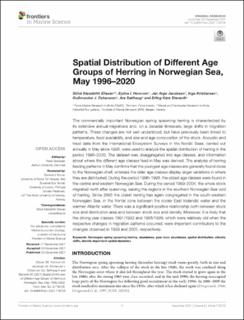| dc.description.abstract | The commercially important Norwegian spring spawning herring is characterized by its extensive annual migrations and, on a decadal timescale, large shifts in migration patterns. These changes are not well understood, but have previously been linked to temperature, food availability, and size and age composition of the stock. Acoustic and trawl data from the International Ecosystem Surveys in the Nordic Seas, carried out annually in May since 1996, were used to analyze the spatial distribution of herring in the period 1996–2020. The dataset was disaggregated into age classes, and information about where the different age classes feed in May was derived. The analysis of herring feeding patterns in May confirms that the youngest age classes are generally found close to the Norwegian shelf, whereas the older age classes display larger variations in where they are distributed. During the period 1996–1998, the oldest age classes were found in the central and western Norwegian Sea. During the period 1999–2004, the whole stock migrated north after spawning, leaving the regions in the southern Norwegian Sea void of herring. Since 2005 the oldest herring has again congregated in the south-western Norwegian Sea, in the frontal zone between the cooler East Icelandic water and the warmer Atlantic water. There was a significant positive relationship both between stock size and distribution area and between stock size and density. Moreover, it is likely that the strong year classes 1991/1992 and 1998/1999, which were relatively old when the respective changes in migration patterns occurred, were important contributors to the changes observed in 1999 and 2005, respectively. | en_US |
